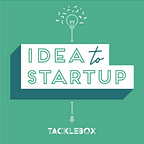By Brian Scordato, Founder of Tacklebox Accelerator and the Idea to Startup Podcast
Because all ideas are not created equal.
You can work on any startup idea you’d like, make sure you choose one worth your time.
The Idea Resume is exactly what it sounds like — when you have a startup idea, this framework helps you create a resume to decide if the idea has enough potential for you to pursue it. Hire ideas wisely
Let’s break it down:
- Problem:
Your startup idea is almost certainly a product idea. The first step of evaluating an idea is to remember the non-negotiable sequence for successful startups:
Problem → Customer → Solution
You can’t cut the line. We start with the problem you’re solving.
Problem Statement: It’s hard for X to Y, and if they can’t, then Z.
X = Customer
Y = Problem
Z = Result of the problem not being solved
How’s it look? Lots of ideas fall apart here, especially if the Z isn’t that big of a deal. Are you solving a problem that actually needs to be solved?
2. Customer:
The first customer will be _____.
Avoid the temptation of listing a demographic i.e. Millenials in Brooklyn who own Arrive suitcases. To get attention, build loyalty, and launch successfully you’ll need a tight starting customer. Can you articulate who this is?
3. Evaluate Need:
Consider the problem and customer you’ve identified above. Is the need real? For this customer, the problem above is:
- Urgent? How urgent is it that they solve this problem?
- Expensive? How expensive is the problem to the customer? How used to paying for a solution are they?
- Known? How painful is this problem to your customer?
- Frequent? How frequently does this problem arise? multiple times a day → a couple of times a year or less
4. Evaluate Customer:
You’ll need to start tight on a customer segment but have you picked the right one? The first customer I’ll work with is:
- Well-funded + willing to spend money to solve the problem
- Influential to future customer segments
- Unified — they have things in common outside of just the problem you’ll solve
- Talkative — they chat with each other about the problem frequently
- Consistent in the value they expect (one product would be great for all of them)
5. Acquisition:
How will you acquire this customer? I could reach 25 customers (B2C) or 5 customers (B2B) this week by _____.
- Do you actually know where your customer is?
- Is this a unique strategy or are all your competitors doing the same thing?
- Is this a repeatable acquisition strategy?
6. Trust:
How will you build trust with this customer? If I had ten words to get my customer’s attention, I’d say _________.
7. Elevator Pitch:
Let’s close this out, how would you answer the below?
We’ll help {detailed customer segment} solve {an urgent, expensive, known and frequent problem}. We’re the right people to do this because {unique experience/skills/insight}.
Ok, now what?
1. Have you identified a real problem that NEEDS solving?
2. Do you have a quality customer to launch with?
3. Do you know enough about the nuances of the problem and customer to create a real solution? Or can you use customer interviews to get to this point?
If you’re nodding along, “yes”, “yes”, “yes” — your resume is top of the pile. Let’s build this thing.
If you’re kind of with us, “maybe”, “kinda”, “sure?” — your resume is in the pile but not a top contender, yet. Learn how we teach our startups to get past this point.
If you don’t have any of these answers — your resume needs a little bit of work before ‘applying’ for your startup. Check out the Idea to Startup Podcast to find another idea.
